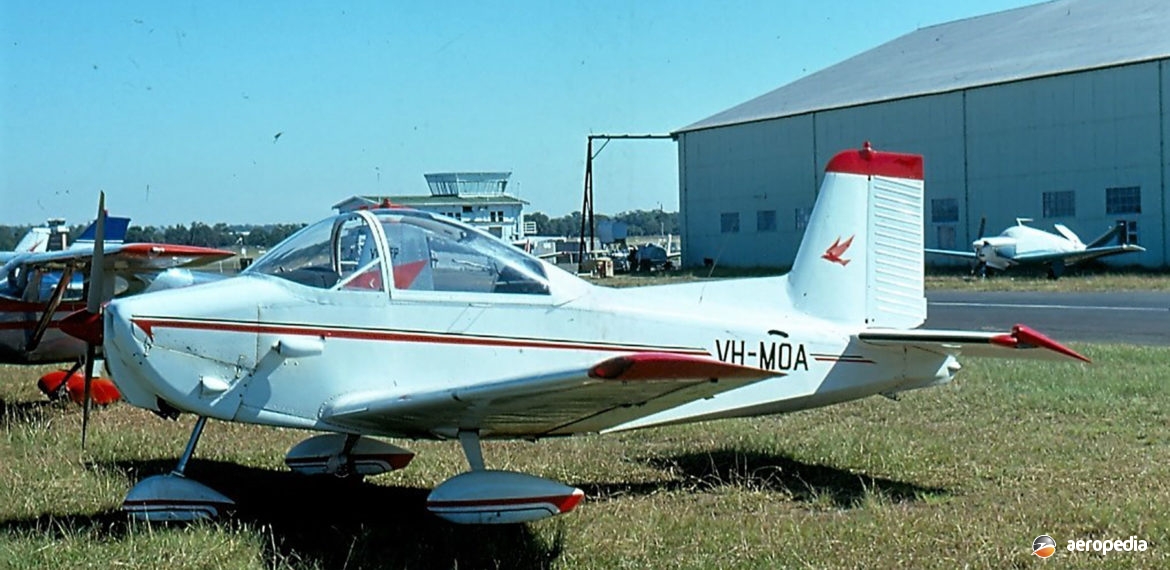Photograph:
Victa Airtourer 100 VH-MOA (c/n 3) at Bankstown, NSW in April 1976 (David C Eyre)
Country of origin:
Australia
Description:
Two-seat light touring and training monoplane
Power Plant:
One 75 kw (100 hp) Rolls-Royce / Continental O-200-A four-cylinder horizontally-opposed air-cooled engine
Specifications:
- Wingspan:7.93 m (26 ft)
- Length: 6.33 m (20 ft 9 in)
- Height: 2.3 m (7 ft 6 in)
- Wing area: 11.15 m² (120 sq ft)
- Max speed: 220 km/h (137 mph)
- Max cruising speed: 203 km/h (126 mph)
- Initial rate of climb: 206 m/min (675 ft/min)
- Service ceiling: 3,962 m (13,000 ft)
- Max range: 1,287 km (800 miles)
- Empty weight: 476 kg (1,050 lb)
- Loaded weight: 748 kg (1,650 lb)
History:
The first Australian designed light aircraft to be granted type approval (on 4 July 1962), the Airtourer was a development of a design by the late Henry Millicer which won the Royal Aero Club design competition for a light aircraft. The wooden prototype VH-FMM (c/n 1) was built and flown with a 48 kw (65 hp) Continental engine for the first time on 10 April 1959. This aircraft was withdrawn from service in 1964 and was subsequently placed in the Museum of Technology in Melbourne, VIC. At about this time a group led by Millicer discussed the possibility of building the Airtourer at Tamworth, NSW with East West Airlines, but this plan did not eventuate.
In 1960 Victa Ltd became interested in production. Its newly formed aviation division was working on the R-2 four-seat monoplane prototype, which was shelved whilst VH-FMM was re-engined with a 67 kw (90 hp) Continental engine, and a new certificate of airworthiness was obtained. A demonstration tour of New Zealand was then made with this machine and plans put in train to make the Airtourer of all-metal construction, this new model then becoming known as the Airtourer 100.
The prototype of the all-metal model VH-MVA (c/n 1) was flown on 12 December 1961, followed by the first production machine VH-MVC (c/n 2) a few months later. Aircraft production proceeded and the type was later offered in two variants, the Models 100 and 115, differing mainly in the type of engine installed. The type became popular with private owners and clubs, and examples were exported overseas, including to the United Kingdom.
Some years ago the Airtourer Association was formed with the late Henry Millicer as patron. This was an association of owners of Victa Airtourers, the then President being the owner of the only Victa Aircruiser built. This organisation obtained rights to the design to ensure a supply of parts. Subsequently the Airtourer, in much modified form, was to be placed back in production at Sale, VIC as the Millicer Airtourer, and one example was completed, this being a rebuild of one of the original Airtourers, the Company also at the time working on the design of a four-seater known as the MAI Shrike, the design of which later became the Aircruiser. The Company later went into liquidation and little, if any, work proceeded on the Shrike.
The Airtourer was exported overseas, particularly to the United Kingdom where it was marketed by Glos Air, the aircraft being assembled at that company’s facility at Staverton Airport in Gloucester. In 2014 a number of examples were still airworthy in the UK. Glos Air eventually entered into an agreement to assemble the aircraft from components supplied from New Zealand, these becoming known as the GlosAir Airtourer.
Over the years owner operators have made changes to their aircraft to increase performance, a number of examples being fitted with the Rolls Royce O-200 four-cylinder engine and becoming known as the Model T.3A. Others have been fitted with the Lycoming O-320 four-cylinder engine, becoming known as the Model T.4.

